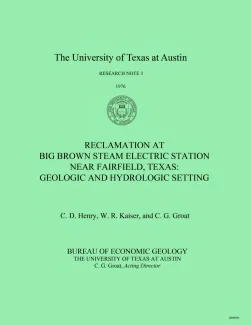Get the Publication
Abstract/Description:
Lignite deposits in Texas occur in three Eocene stratigraphic units: the Wilcox Group (lower Eocene), the Yegua Formation (upper Eocene), and the Jackson Group (upper Eocene). They are part of an extremely thick Gulf Coast Tertiary clastic sequence composed of an alternation of fluvial-deltaic and marine units. At the outcrop, the marine units are volumetrically insignificant. All units dip coastward at 1/4 deg to 2 deg (about 20 to 180 ft/mile).
In Texas, the Wilcox Group, the most important lignite-bearing unit, was deposited in fluvial systems and delta systems updip and delta systems downdip in east-central and northeast Texas and in barrier-bar lagoon systems in South Texas (Fisher and McGowen, 1967).
The Wilcox Group in the vicinity of Fairfield has been subdivided into three formations (Barnes, 1970) (figs. 1 and 2). From oldest to youngest, they are the Hooper Formation composed of mud and sand, the Simsboro Formation of sand, and the Calvert Bluff Formation of sand and mud. The Hooper conformably overlies the Midway marine shales. The Simsboro rests conformably and unconformably on the Hooper and has been interpreted as a coarse-grained meanderbelt deposit (McGowen and Garner, 1970). The Calvert Bluff conformably overlies the Simsboro.
Regional lithofacies mapping of the Calvert Bluff Formation shows that at the outcrop it was deposited as a fluvial system (Kaiser, 1975, unpublished data). Major channel deposits (thick sands) are isolated at the surface, surrounded by extensive interchannel floodbasin deposits of sandy mud or mud and laminated sand and clay.
